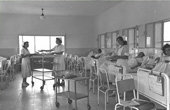Those involved in the design and construction of hospitals often have little hard scientific knowledge of ‘healing environments’ and the knowledge that they do have, is not being used. These are conclusions of the research carried out by PhD candidate Milee Herweijer. She argues for improved knowledge sharing and better use of the academic research that is available in order to create better hospitals.
The term ‘healing environment’ is widely used in the world of hospital construction, but what does it actually mean? As Herweijer discovered, it is used in a lot of different ways. One person uses it meaning a patient-friendly approach, and another to meaning a building with good natural light ingress. However, Herweijer states that rather than bandying about a vague term, we should be focusing on academically supported knowledge - particularly during the design process. “Surprisingly enough, this knowledge is not commonplace in the Netherlands, and I would like to do something about this with my research.”
In her thesis 'Evidence-Based Design in Nederlandse Ziekenhuizen. Ruimtelijke kwaliteiten die van invloed zijn op welbevinden en gezondheid van patiënten' (Evidence-based design in Dutch hospitals, Spatial qualities that influence the well-being and health of patients) she first of all conducted a literature study on Evidence-Based Design (EBD). In the USA in particular there is a wealth of information on what things actually effect the healing process. For example, patients feel better in single rooms, preferably with good acoustics and lighting. Having a room to yourself reduces the risk of infection from other patients and – more importantly – it offers more privacy. Patients also sleep more soundly in single rooms. Views of nature, good natural lighting, and facilities for walking in green spaces all add to a sense of well-being. This results in less stress, less pain, improved sleep and ultimately to a quicker recovery. Well designed areas for the medical staff and minimising the walking distance to the patient – for example by establishing decentralised nurses stations – are also important. They ensure that the staff have more time for their patients and experience more pleasure in their work. A lack of privacy in waiting rooms and examination rooms works counterproductively. It can cause embarrassment on the part of the patient, who may then not be fully open with the doctor, which gives a false start to the hospital admission.
Florence Nightingale
Herweijer used her literature survey as the basis for a checklist showing proven effective spatial measures for EBD. She then took this checklist to nine recently built hospitals in the Netherlands. The results were disappointing. Hospitals do not make the most of opportunities for using the building design to promote the healing process, or they try to do it without consulting the academic research which is available. Herweijer: “Hospitals and designers are continuously trying to reinvent the wheel. We are not learning from the available research.”
The reasons for this are not part of her research, but she suspects it may sometimes be because the subject gets snowed under during the lengthy construction processes. But more often than not it is because of a lack of awareness of the proven academic knowledge available on ‘healing environments’. There are no guidelines for this in the Netherlands, no centres of expertise, such as the Center for Health Design in the USA that gathers this knowledge together. Herweijer argues for a similar centre in the Netherlands. Her PhD research could be a first step on the way to achieving this. She also feels we should make more use of patients' opinions.
She finds it incomprehensible that up to now no systematic record has been made of this knowledge of EBD. “As far back as 1850 Florence Nightingale reported that a patient who has views of nature recovers more quickly than one who only has a brick wall to look at. What has gone wrong with our capacity to learn if even that is still not common knowledge?”
Published: April 2016
More information
- PhD thesis ' Evidence-Based Design in Nederlandse ziekenhuizen: Ruimtelijke kwaliteiten die van invloed zijn op het welbevinden en de gezondheid van patiënten' (Dutch only)
